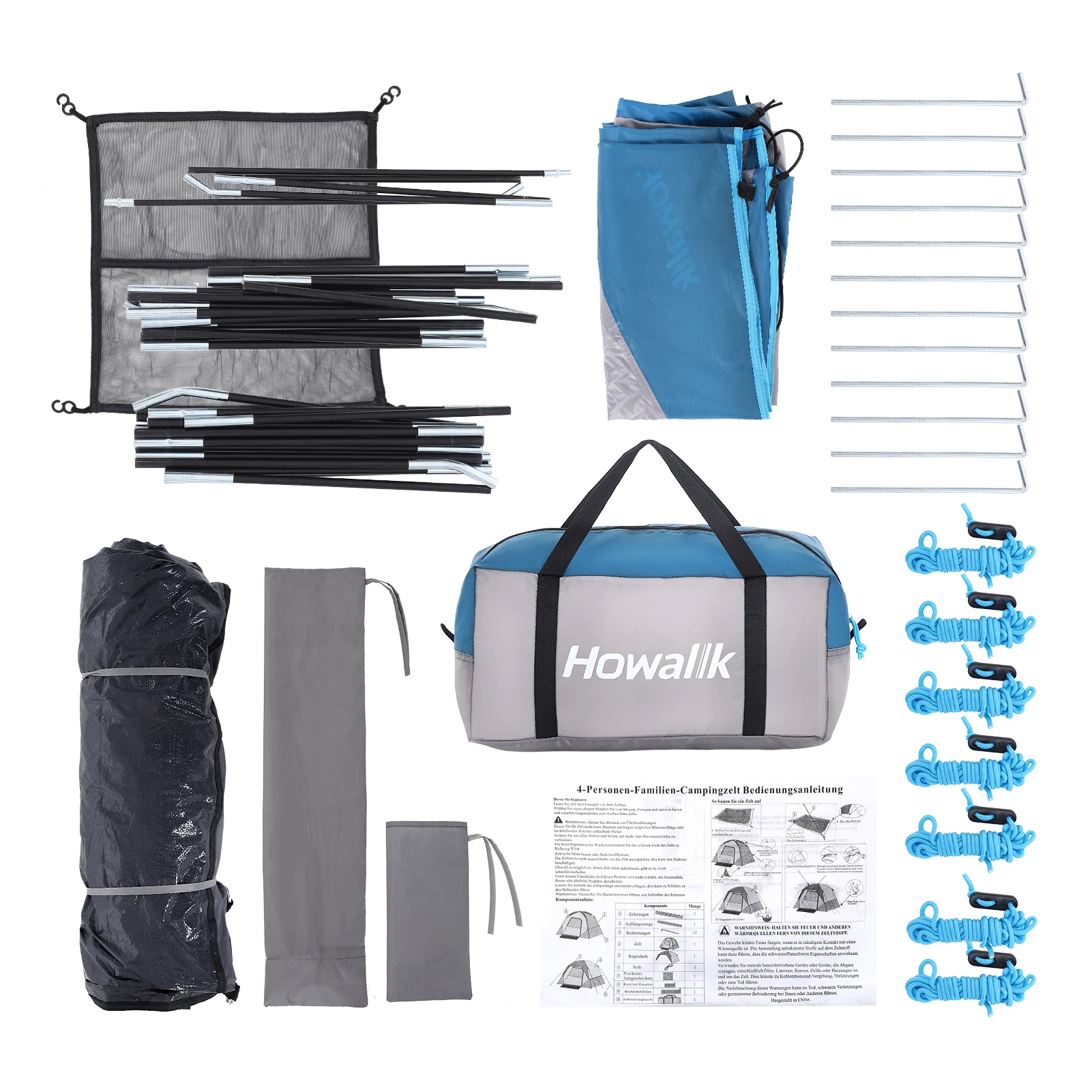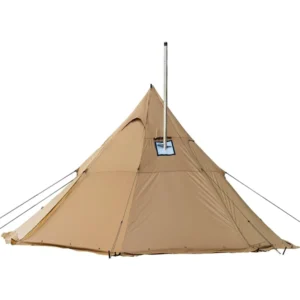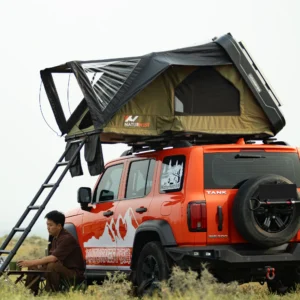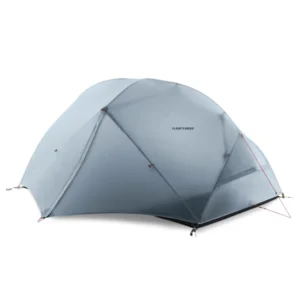1. The Critical Importance of Wind Resistance in Alpine Environments
When venturing into the mountains, wind resistance isn’t just a feature—it’s a necessity that can determine your safety and comfort. Wind resistance in alpine tents refers to a shelter’s ability to maintain structural integrity and protect occupants when facing powerful mountain gusts and sustained winds.
Alpine environments present unique challenges that make robust wind resistance crucial:
- Sudden weather changes can transform calm conditions into howling gales within minutes
- Wind speeds at altitude frequently reach 40-60 mph (65-95 km/h), with some areas experiencing much higher
- Exposed ridges, passes, and plateaus offer little natural protection from wind
- The combination of high winds and low temperatures dramatically increases hypothermia risk
A tent that fails under these conditions doesn’t just mean discomfort—it can lead to dangerous exposure, gear damage, or being left without shelter in potentially life-threatening situations.
Throughout this guide, we’ll explore the science behind wind-resistant designs, the critical components that determine performance, and practical advice for selecting and using alpine tents in windy conditions. Our insights come from extensive field testing across diverse mountain environments and scientific understanding of how wind interacts with tent structures.
The foundation of shelter options for two campers changes dramatically in alpine settings, where understanding what makes a tent truly windproof becomes essential knowledge rather than a luxury.
2. Understanding Wind Behavior in Mountain Settings
To appreciate why alpine tents require specialized design, it’s important to understand how wind behaves in mountain environments and the forces it exerts on your shelter.
Wind power increases exponentially with speed—doubling the wind speed quadruples the force it exerts. This means a seemingly modest increase from 20 mph to 40 mph (32 km/h to 64 km/h) creates four times more pressure on your tent structure.
Mountains create distinctive wind patterns that further complicate matters:
- Katabatic winds flow downhill as cold air descends from peaks and ridges
- Valley corridors funnel and accelerate wind, creating natural wind tunnels
- Ridge exposures catch the full force of prevailing winds with no obstruction
- Terrain features create unpredictable turbulence and shifting directions
These wind patterns subject tents to complex forces: positive pressure on windward sides, negative pressure (suction) on leeward sides, and shearing forces that twist and distort the structure. Properly designed alpine tents address all these forces through specialized architectural elements.
When setting up camp, understanding these dynamics helps you anticipate how navigating nature’s fury requires durable tents specifically engineered for these conditions.
3. Aerodynamic Design: How Tent Shapes Handle Wind
The shape of your tent is the first line of defense against alpine winds. Different designs offer varying advantages in terms of wind resistance, usability, and weight considerations.
Geodesic Domes
These feature multiple pole crossings creating triangular patterns that distribute stress exceptionally well. Their relatively symmetrical design handles wind from multiple directions, making them ideal for exposed positions where wind direction may change. The trade-off comes in slightly increased weight and complexity.
Tunnel Tents
With their elongated design, tunnel tents excel at handling wind from front or rear but require proper orientation relative to wind direction. When properly positioned, their aerodynamic shape allows wind to flow smoothly over the structure with minimal resistance, but they can struggle with strong crosswinds.
Pyramid/Mid Designs
Simple and efficient, these single-pole structures shed wind effectively with their sloped walls. They perform admirably in snow conditions but can have vulnerability to certain wind angles that stress the single central support point.
A-frame/Ridge Designs
While historically common, traditional A-frame designs present flat surfaces to wind and typically offer less stability in strong gusts than more modern designs.
Regardless of design type, key aerodynamic principles apply:
- Low profiles reduce the surface area exposed to wind
- Curved surfaces shed wind more effectively than flat ones
- Symmetrical designs distribute wind pressure more evenly
- Sloped walls minimize direct wind resistance
When selecting from heavy duty 4-season tents, these aerodynamic considerations should be primary factors in your decision-making process.
4. Pole Structure: The Skeleton That Withstands the Storm
The pole system forms the critical framework that maintains your tent’s shape and stability against powerful winds. Material choice, diameter, configuration, and attachment methods all contribute to wind performance.
Pole Materials and Their Wind Performance
- Aluminum Alloys: The most common choice, offering excellent strength-to-weight ratio. Premium alloys like 7000-series aluminum provide superior resilience against bending while maintaining flexibility to absorb gusts.
- Carbon Fiber: Ultralight with impressive strength, but typically more brittle than aluminum. Better in sustained winds than gusty conditions due to less flex.
- Pole Diameter and Thickness: Alpine tents typically feature poles 8-10mm (0.3-0.4in) in diameter with thicker walls than lighter backpacking models.
Configuration and Structure
The architectural design of the pole system dramatically affects wind resistance:
* More pole crossings create stronger triangulated structures
* External pole systems provide better structural support than internal ones
* Connected hub designs distribute force across the entire system
* Internal guy systems that connect poles to the tent body prevent excessive movement
Attachment Methods
How poles connect to the tent fabric affects wind performance:
* Sleeve Systems: Distribute wind pressure evenly along the entire pole length but can be challenging to set up in windy conditions
* Clip Systems: Easier to pitch but create more concentrated stress points
* Hybrid Systems: Combine sleeves at critical points with clips elsewhere for balanced performance
The tent’s internal structure may also include additional supports like internal guy lines or hub systems that further enhance stability by connecting key stress points.
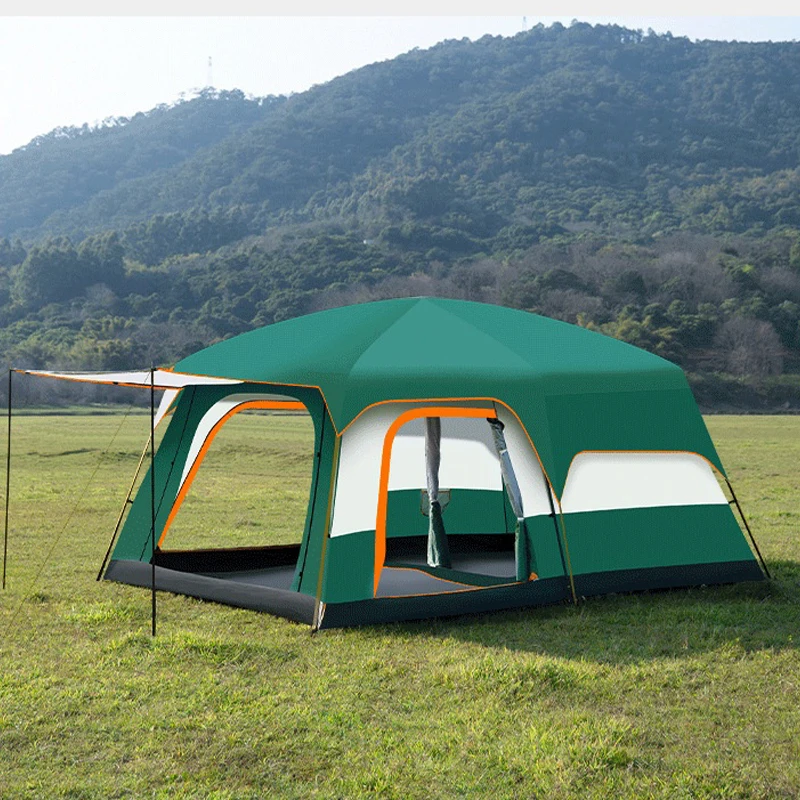
For adventures in extreme conditions, the pole structure becomes even more crucial when selecting 4-season winter 2-person tents that must withstand significant wind loads while keeping you protected.
5. Fabric Technology: The Shield Against Wind and Weather
While the pole structure creates the framework, the fabric is what ultimately faces the direct impact of wind and weather. The right materials make the difference between a tent that withstands alpine conditions and one that fails when you need it most.
Fabric Considerations for Wind Resistance
Denier Rating: This measurement of thread thickness directly correlates with fabric strength. Alpine tents typically feature:
* Flysheets: 30-70D (denier) material
* Floor fabric: 40-100D for durability
* Higher denier means greater tear strength but increased weight
Ripstop Construction: This reinforcement technique incorporates stronger threads in a grid pattern throughout the fabric, preventing small tears from spreading. Nearly all quality alpine tents feature ripstop nylon or polyester.
Stretch Characteristics: How fabric responds to pressure affects wind performance:
* Some stretch allows the material to absorb gusts without transferring all force to poles
* Too much stretch can deform the tent shape and compromise structural integrity
Material Comparison
| Material | Wind Performance | Strengths | Considerations |
|---|---|---|---|
| Nylon | Excellent | Superior strength-to-weight ratio, natural stretch absorbs gusts | Absorbs moisture and sags when wet |
| Polyester | Very Good | Maintains tension when wet, better UV resistance | Less natural stretch, slightly heavier for equivalent strength |
| Advanced Fabrics | Outstanding | Exceptional tear strength, waterproofing | Premium price point |
Critical Reinforcement Points
Wind resistance depends not just on the fabric itself but on reinforced stress points where:
* Poles attach to the tent body
* Guy line attachment points distribute tension
* Seams join panels together
* Doors and vents create potential weak points
Understanding the most durable tent material options helps you make informed choices when investing in alpine shelters where fabric performance can be the difference between comfort and catastrophe.
6. Anchoring Systems: Securing Against Lift and Movement
Even the best-designed tent will fail if it isn’t properly anchored to the ground. In alpine environments, where wind can create substantial lift and lateral forces, your anchoring system becomes crucial.
Guy Line Systems
A comprehensive guy line setup is essential for wind stability:
- Materials: Look for low-stretch, high-strength cord that won’t sag when wet
- Strategic Placement: Most alpine tents include 6-10 guy points positioned to counteract specific wind directions
- Tensioning Systems: Line tensioners allow quick adjustments as conditions change
- Reflective Cording: Makes guy lines visible in low light, preventing tripping hazards
Stakes and Ground Anchors
The connection between your tent and the earth requires appropriate hardware:
- Types for Different Terrain:
- Y-shaped or V-shaped stakes offer superior holding power in most soil
- Snow stakes (wider, flat design) distribute force in snow
- Rock anchors for solid surfaces where stakes won’t penetrate
- Proper Placement: Angling stakes at approximately 45 degrees toward the tent increases holding power
- Quantity: Alpine conditions typically require using every stake point plus supplementary anchors
Alternative Anchoring Methods
When traditional staking isn’t possible:
* Snow burial techniques (deadman anchors)
* Rock stacking to secure guy lines
* Natural anchors like trees or large rocks
Distributing tension across multiple anchor points prevents any single failure point from compromising your entire shelter, especially important when dealing with the unique challenges of freestanding tents on rocky terrain where traditional staking may be limited.
7. Understanding Performance Ratings and Specifications
Interpreting manufacturer specifications helps you select the right tent for your alpine adventures, but these ratings require careful understanding.
Seasonal Ratings Decoded
- 3-Season Tents: Designed for spring through fall conditions, typically with less robust pole structures and more mesh for ventilation. Limited wind resistance.
- 3-4 Season Tents: Hybrid designs with reinforced structures but still incorporating ventilation. Moderate wind resistance.
- 4-Season Tents: Engineered specifically for winter and alpine conditions with stronger poles, more guy points, and less mesh. Superior wind resistance.
- Expedition/Mountaineering Tents: The most robust category, built to withstand extreme conditions including high-altitude storms. Maximum wind resistance.
Wind Resistance Ratings
Understanding manufacturer claims requires context:
* Wind ratings typically range from 40-80 mph (65-130 km/h) for alpine tents
* “Survival rating” indicates maximum wind a properly pitched tent can withstand without catastrophic failure
* “Functional rating” indicates conditions where the tent remains comfortable and stable
* Laboratory testing often differs from real-world conditions, particularly in gusty scenarios
Shopping Guidance
When evaluating specifications:
* Look for actual wind tunnel test results rather than marketing claims
* Consider pole diameter and material alongside the stated wind rating
* Count the number of guy line attachment points (more is better for wind stability)
* Evaluate the symmetry of the design for multi-directional wind performance
For serious alpine adventures, exploring purpose-built mountaineering tents provides options specifically engineered for exceptional wind resistance in extreme conditions.
8. Selecting the Right Alpine Tent for Your Wind Conditions
Finding the perfect balance between wind resistance and other considerations requires matching tent capabilities to your specific alpine environment and personal priorities.
Assessing Your Needs
Consider these factors when selecting your alpine tent:
* Typical wind speeds and patterns in your destination mountains
* Camp positioning options (protected valleys vs. exposed ridges)
* Trip duration and weight constraints
* Group size and space requirements
* Budget limitations and value considerations
Single-Wall vs. Double-Wall Designs
Both architectures offer different wind performance profiles:
* Single-Wall Tents: Lighter weight with fewer components to catch wind, but potentially less stable in extreme conditions and more prone to condensation
* Double-Wall Tents: Typically more stable with better ventilation, but heavier and with more components that could fail
Ventilation Considerations
Proper airflow does more than prevent condensation—it affects wind performance:
* Inadequate ventilation creates internal pressure differences that can destabilize the tent
* Adjustable venting allows adaptation to changing wind conditions
* Strategic vent placement prevents wind from channeling directly through the tent
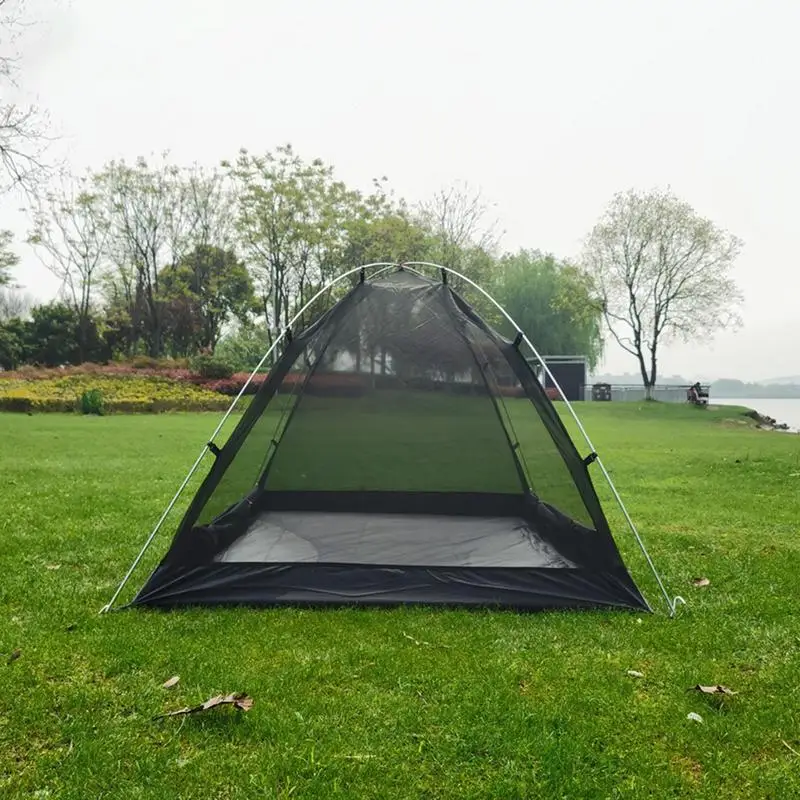
For maximum protection in extreme conditions, winter camping tents offer specialized features designed to handle the harshest alpine winds while keeping you safe and comfortable.
Heavy Duty 4 Season Tent, Mountaineering Tent, Winter Camping Tent
$870.40 Select options This product has multiple variants. The options may be chosen on the product pageUltralight Backpacking Tent, Ultralight Dome Tent, Winter Camping Tent
Price range: $369.63 through $370.07 Select options This product has multiple variants. The options may be chosen on the product pageHeavy Duty 4 Season Tent, Ultralight Freestanding Tent, Winter Camping Tent
$3,722.66 Select options This product has multiple variants. The options may be chosen on the product pageHeavy Duty 4 Season Tent, Winter Camping Tent
$638.69 Select options This product has multiple variants. The options may be chosen on the product pageHeavy Duty 4 Season Tent, Winter Camping Tent
$5,109.59 Select options This product has multiple variants. The options may be chosen on the product pageBackpacking Tent with Vestibule, Heavy Duty 4 Season Tent, Trekking Pole Backpacking Tent, Winter Camping Tent
Price range: $257.52 through $537.51 Select options This product has multiple variants. The options may be chosen on the product page
9. Expert Pitching Techniques for Maximum Wind Resistance
Even the most wind-resistant tent requires proper setup to perform at its best. These expert techniques maximize stability in challenging alpine conditions.
Pre-Pitch Planning
Before taking your tent out of its bag:
* Scout for natural windbreaks like boulders, trees, or terrain depressions
* Observe existing snow or grass patterns to identify prevailing wind direction
* Prepare all components (poles, stakes, guy lines) before exposing the tent body
* Consider creating a snow wall for additional protection if conditions permit
Strategic Setup Sequence
Follow this order for maximum control in windy conditions:
1. Position the tent with its lowest, most aerodynamic end facing the prevailing wind
2. Secure the windward corner first with a solid stake or anchor
3. Insert poles while keeping the tent low to the ground
4. Gradually raise the structure while maintaining tension on the windward side
5. Secure remaining corners, adjusting for even tension
6. Add the rainfly from the windward side if using a double-wall design
7. Deploy all guy lines, beginning with those on the windward side
Guy Line Deployment
Proper tensioning makes all the difference:
* Set lines at approximately 45-degree angles for optimal holding power
* Ensure even tension across all attachment points
* Create opposing anchor points for maximum stability
* Use adjusters to maintain tension as conditions change or lines stretch
These techniques complement knowledge about mastering two-person lightweight tent setup but with additional focus on wind management that becomes crucial in alpine environments.
10. Living in Your Tent During High Winds
Once your alpine tent is properly pitched, managing life inside during prolonged wind events requires additional strategies for comfort and safety.
Minimizing Movement and Noise
- Position sleeping pads and bags perpendicular to the wind direction
- Use gear to create additional bracing inside the tent where needed
- Place heavier items along the tent perimeter to add stability
- Consider earplugs for sleeping during particularly noisy wind conditions
Managing Condensation
Wind events often accompany weather systems that create condensation challenges:
* Minimize cooking inside the tent to reduce moisture
* Keep wet gear in vestibules when possible
* Use a small absorbent cloth to wipe down trouble spots
* Adjust ventilation without creating direct wind tunnels
Reinforcement During Storms
If conditions deteriorate:
* Periodically check and retension guy lines
* Clear snow accumulation before it builds up excessive weight
* Monitor pole flex and add temporary internal supports if needed
* Position your body to brace key sections during extreme gusts if necessary
For multi-day trips, the psychological aspect of enduring extended wind events is just as important as technical considerations. Develop mental routines and remember that most storms eventually pass.
The design characteristics that create best all-season tent performance, durability and value become especially apparent when living through significant wind events in alpine settings.
11. Can Any 3-Season Tent Work in Alpine Wind Conditions?
Many outdoor enthusiasts wonder if their existing 3-season tent can handle alpine conditions, avoiding the investment in a specialized 4-season model.
While most standard 3-season tents are designed for winds up to 25-30 mph (40-48 km/h), they generally become unsafe in the 35+ mph (56+ km/h) winds common in alpine settings. However, not all 3-season tents are created equal.
Some 3-season models may perform adequately in mild alpine conditions if they feature:
* Geodesic or semi-geodesic pole structures with multiple crossing points
* Lower profiles with minimal flat surface areas
* Quality pole materials (DAC or similar aluminum)
* Sufficient guy line attachment points
Possible modifications to improve a 3-season tent’s wind resistance include:
* Adding supplementary guy lines to existing attachment points
* Using sturdier aftermarket stakes
* Setting up in naturally protected locations
* Creating windbreaks with natural materials
However, when forecasts predict sustained winds over 30 mph (48 km/h) or gusty conditions, a proper alpine tent becomes necessary for safety, not just comfort.
For those seeking versatility, some ultralight freestanding tents incorporate design elements that enhance wind resistance while maintaining reasonable weight, potentially bridging the gap between categories.
12. How Do Different Pole Materials Compare in High Winds?
The material composition of your tent poles plays a crucial role in determining how they’ll perform when alpine winds test their limits.
Standard Aluminum:
* Moderate flexibility absorbs gusts without breaking
* Good strength-to-weight ratio
* Affordable and repairable in the field
* May permanently deform under extreme stress
Premium Aluminum Alloys (7000-series):
* Enhanced strength with similar flexibility
* Superior resistance to permanent deformation
* Lightweight with excellent durability
* Higher cost but worthwhile investment for alpine conditions
Carbon Fiber:
* Extremely lightweight (typically 30-40% lighter than aluminum)
* Very stiff with minimal flex
* Excellent performance in steady winds
* More prone to catastrophic failure than bending
* Difficult or impossible to repair in the field
The ideal choice often depends on the specific conditions you expect to encounter. Carbon fiber excels in settings with predictable, sustained winds where weight savings are critical. Premium aluminum alloys offer the best overall performance in variable conditions with gusty, changeable winds typical of many alpine environments.
Understanding these material differences helps explain why certain tents excel in weather resistance and durability for camping tents under challenging mountain conditions.
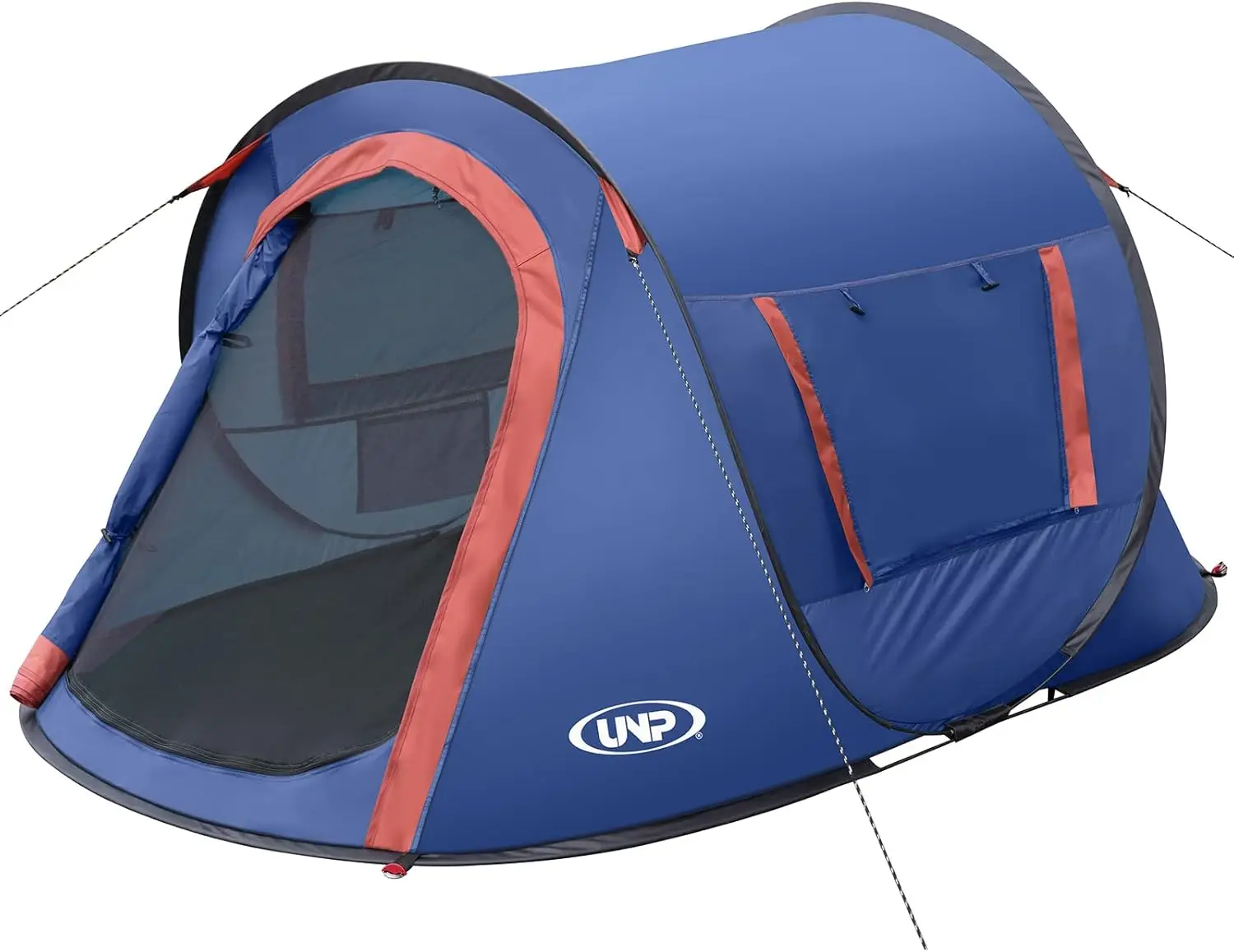
13. What Emergency Measures Can Save Your Tent in Extreme Wind?
Even with proper planning and equipment, you may occasionally face wind conditions that exceed your tent’s design limits. Knowing emergency reinforcement techniques can save your shelter—and potentially your safety margin.
Emergency Reinforcement Techniques
- Create additional anchor points using trekking poles driven horizontally under the tent edges
- Use backpacks filled with heavy items as internal bracing against tent walls
- Add improvised guy lines using spare cordage attached to pack straps or other strong points
- Build snow walls on windward sides to reduce direct wind impact
- Stack rocks or other heavy objects along tent edges (without creating puncture risks)
Quick Repairs for Wind Damage
- Carry repair sleeves to splint cracked poles
- Use duct tape to temporarily seal torn fabric sections
- Employ a tent-specific repair kit with fabric patches and seam sealer
- Use cordage to lash broken poles together in functional configurations
Knowing When to Retreat
Sometimes the safest option is abandoning the tent:
* When multiple poles have failed and the structure is compromised
* If the tent location becomes unsafe due to developing conditions
* When repairs cannot make the shelter functional again
Having knowledge about alternative camping shelter options for two can provide backup plans when primary shelters fail, creating redundancy in your alpine safety system.
At Explore Elements, we design our alpine tents understanding that they’re not just camping accessories—they’re critical safety equipment for mountain environments. By incorporating advanced wind-resistant features and thoroughly testing our designs in real-world alpine conditions, we ensure your shelter will stand up to the challenges that high mountain environments present.

